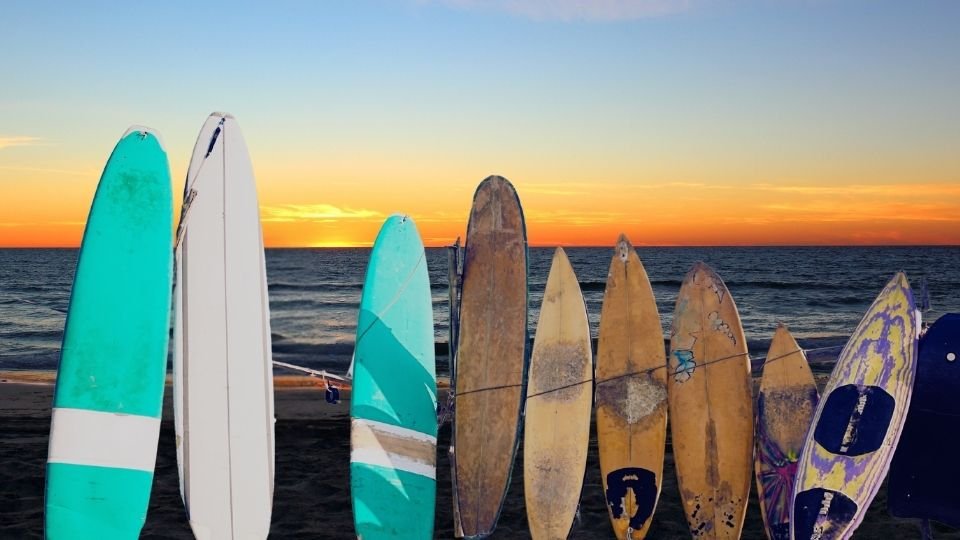
How to Choose the Right Surfboard for Your Level. Find out how to choose the best surfboard for your skill level! Whether you’re a beginner, intermediate, or advanced surfer, this guide will help you select the perfect board to enhance your surfing experience.
Choosing the right surfboard is essential to your progress and enjoyment in surfing. Whether you’re a complete beginner or an experienced surfer, selecting the right board can make a huge difference in how well you ride the waves. In this guide, we’ll walk you through the factors to consider and help you choose the perfect surfboard based on your level and the waves you ride.
Why the Right Surfboard Matters
When you’re learning to surf, your surfboard is your best tool for success. If you choose the wrong board for your skill level, you might struggle with balance, paddling, and catching waves. On the other hand, a well-chosen board can help you catch more waves, improve your technique, and have more fun in the water.
By understanding your surfing level and what type of board fits your needs, you can make a more informed decision and speed up your learning process.
Key Factors to Consider When Choosing a Surfboard
1. Skill Level
Your skill level is the most important factor in choosing the right surfboard. Here’s a quick overview:
- Beginner: If you’re just starting out, you’ll need a board that provides stability and float.
- Intermediate: As an intermediate surfer, you’ll want a board that offers a balance between maneuverability and stability.
- Advanced: Advanced surfers need boards that are agile and responsive, helping them perform advanced maneuvers.
2. Volume
Volume refers to the amount of float your board has, and it’s measured in liters. A higher volume provides more buoyancy, making it easier to catch waves and balance. For beginners, a board with more volume will be easier to paddle and stand up on. Intermediate and advanced surfers might prefer a lower volume for better control and performance.
3. Length
Longer boards are easier to balance on and catch waves, but they’re harder to maneuver. Shorter boards are more agile and perform better in big waves, but they require more skill to ride. A longboard (8’0” or more) is perfect for beginners, while an intermediate surfer might benefit from a funboard or mini mal (7’0” – 8’0”). Advanced surfers usually prefer a shortboard (5’6” – 6’4”).
4. Shape and Design
The shape of your surfboard affects how it handles waves. For example:
- Round Nose: Offers stability and is forgiving.
- Squash Tail: Provides more control for carving turns.
- Pin Tail: Best for fast, steep waves.
Choosing the right shape depends on the conditions you usually surf and your personal style.
Best Surfboards for Different Skill Levels
Best Surfboards for Beginners
As a beginner, you’ll need a board that provides maximum stability and makes it easier to catch waves.
Soft Top Longboard (8’0” – 9’0”)
A soft top longboard is the best choice for beginners. These boards are wider, longer, and offer more float, making it easier to balance and paddle out. The soft top also reduces the risk of injury when you fall.
Benefits:
- Easy to paddle and balance on
- Perfect for catching small waves
- Provides plenty of stability
Funboards and Mini Mals (7’0” – 8’0”)
Funboards are a great transition board for those who have mastered the basics and are looking for a board that’s still stable but offers more maneuverability.
Benefits:
- Great for small to medium-sized waves
- Allows you to start working on turns
Best Surfboards for Intermediate Surfers
As you progress, you’ll want a board that provides more control while still being forgiving.
Fish Surfboard (5’6″ – 6’6”)
Fish boards are shorter, wider, and often have a split tail. They’re perfect for smaller waves, but their width makes them stable, which is great for intermediates looking to improve their turns.
Benefits:
- Fast and fun
- Performs well in small to medium surf
- Easier to maneuver than longboards
Hybrid Surfboards
Hybrid boards are a blend of fish and shortboards. They combine stability with maneuverability, making them ideal for intermediate surfers who want to challenge themselves without jumping straight to a performance shortboard.
Benefits:
- Versatile in a wide range of conditions
- Great for experimenting with new maneuvers
Best Surfboards for Advanced Surfers
Advanced surfers need a board that’s responsive, fast, and perfect for high-performance surfing.
Shortboard (5’6” – 6’4”)
The shortboard is the go-to surfboard for advanced surfers. It’s designed for quick maneuvers and works well in steep, powerful waves. These boards are best for those who can make quick decisions and execute complex maneuvers.
Benefits:
- Fast, responsive, and ideal for performance surfing
- Works best in bigger waves
- Allows for sharp turns, aerials, and other advanced moves
Step-Up Board
For larger waves, a step-up board gives you more length and paddle power. It’s slightly longer than a typical shortboard but still responsive enough for high-performance surfing.
Benefits:
- Best for larger, more powerful waves
- Allows you to maintain speed and control on big faces
How to Improve Your Surfing with the Right Board
Your board is more than just equipment—it’s a key to unlocking your surfing potential. Choose a board that matches your level, and you’ll notice improvements in how you catch waves, how much control you have, and how much more fun you have on the water.
Quick Tips:
- Try Before You Buy: Rent boards to test different shapes and sizes.
- Listen to Experts: Surf shop employees and instructors can give you great advice based on local conditions.
- Match the Board to the Waves: Consider the wave size and conditions when choosing a board.
Conclusion: Find Your Perfect Board
Choosing the right surfboard depends on your level, the waves you surf, and your personal style. From beginners starting with a soft top longboard to advanced surfers seeking the perfect shortboard or step-up, the right surfboard can accelerate your learning and enhance your experience.
By understanding key features like volume, length, and shape, you can confidently choose a board that will help you progress. Don’t rush the process—take your time, experiment, and find what works best for you. Ready to catch the perfect wave? Start with the right board, and the rest will follow.





